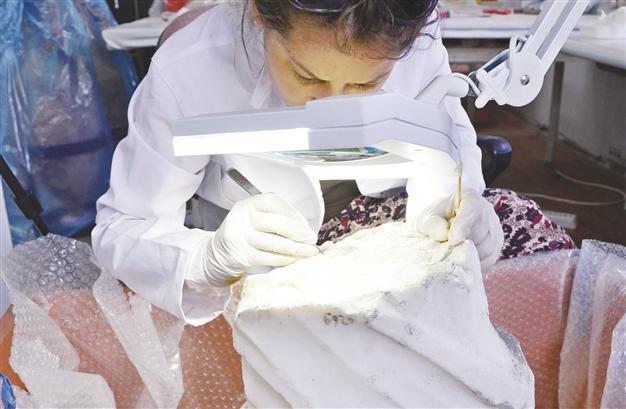Bodrum Museum foster artifacts at laboratories
MUĞLA - Anatolia News Agency

After the professionals have done the necessary work on the artifacts at the laboratories, they send them to the museum, says the museum official Yaşar Yıldız. AA photos
Bodrum Tower and Underwater
Museum’s artworks are going on display after undergoing analysis by laboratory conservation professionals.
Speaking to the Anatolia News Agency, the museum’s director Yaşar Yıldız said there were many artifacts waiting to be restored in the storage section of the museum.
“Conservation is being done for these historical artifacts in order to protect them for many years. We have sent them to the laboratories,” Yıldız said.
After the professionals have done the necessary work on the artifacts, they send them to the museum, he said, noting that some of the works were being displayed and some of them were being kept in storage.
“It is very important to clean and protect the artworks,” said Yıldız. “Consolidation, cleaning, renovation are among the operations that they are undergoing.”
Each artifact is registered at the museum. “It is like a doctor keeping the patient’s card and taking care of his or her patient,” Yıldız said.
“Each artifact has its own card which explains what operations it has gone through,” he said, adding that the most important section of the museum was the conservation part. “In the U.S., the Metropolitan Museum has a conservation center for glass, paper and ceramic works and all materials have an exclusive conservation section … We are also working with a specialized team for the conservation of our works.”
Conservation professional, Sinem Köstak, who graduated from Istanbul University’s Conservation and Protection department, said artifacts were first cleaned from sea water before being taken into the protection and conservation stage.
The artifacts should be conserved in a space where there is no light, Köstak said, adding that after the first phase the different parts of the artifacts were reattached together.
“It is meticulous job to paint and preserve the artifacts. Everything must be done by millimetric measurements and everyone should be very careful … We need to work in parallel with the artifacts, otherwise we could damage them,” she said.
Köstak said the museum’s conservation department usually worked on sculptures, vases, and bowls.
New conservation trend in Turkey’s museumsBodrum Tower and Underwater Museum’s conservation works are only the latest in a recent upsurge in restoration and conservation projects in Turkey. Turkey’s first restoration conservation and analysis laboratory recently set to work restoring a wide array of historical artifacts using state-of-the-art technology in the southeastern province of Mardin’s main museum.
“More than 5,000 artifacts have so far been restored and conserved in the laboratory. Along with metal artifacts like gold, silver, copper, bronze and iron, all organic and inorganic mobile artifacts like ceramics, glass, mosaics, wood, paper leather and textiles are also restored here,” said Mardin Museum Director Nihat Erdoğan.
“Also, various analyses and tests regarding the façade problems of historical Mardin structures, which are very important in Turkey and the world in terms of their architectural features, as well as their solutions, are being conducted in this laboratory,” he said. The director said the southeastern province’s museum had turned into an educational, scientific and communication center thanks to the laboratory.
Türkiye İş Bank has also opened a painting conservation and restoration laboratory, as part of Istanbul’s Mimar Sinan University. While the new laboratory will serve as a scientific base for the conservation and restoration of paintings, it will also be a base to cultivate professional support of restoration. The laboratory will welcome its first students this year.
İş Bank’s collection, one of the largest in Turkey, will also be conserved and restored at this laboratory by Turkish professionals.
The opening of the laboratory was attended by Culture and Tourism Minister Ertuğrul Günay, İş Bank Chairman Ersin Özince, İş Bank General Manager Adnan Bali, and Mimar Sinan Fine Arts Department Rector Yalçın Karayağız.
Speaking during the opening ceremony, Özince said the laboratory showed confidence in Turkish painting and its evolution over time. “Thanks to the new laboratory, the whole İş Bank collection will be protected. This is a huge development not only for the İş Bank collection, but also for Turkish painting’s history and future,” Özince said.
The new students at the laboratory will give Turkey special restoration resources and the work will be conducted to international standards, said Özince.
